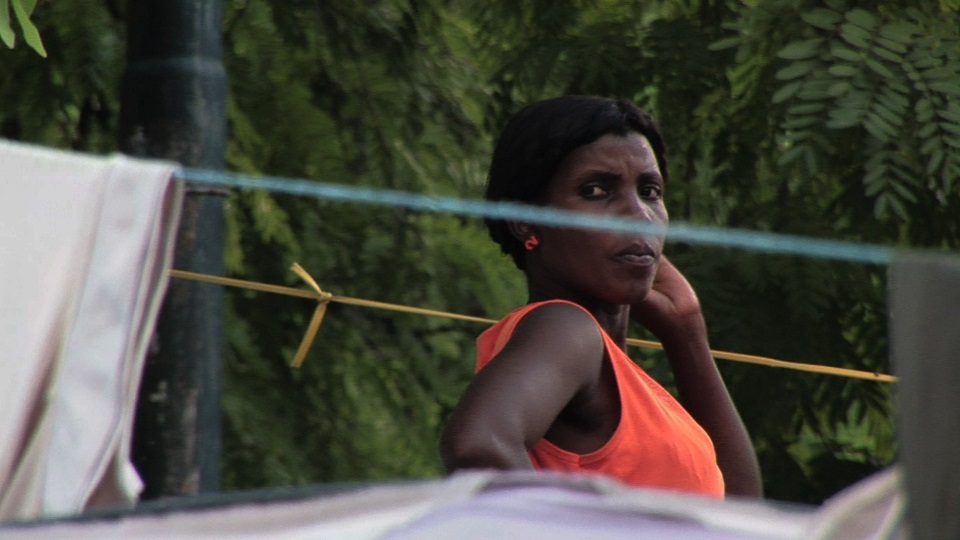
They say “if it bleeds, it leads,” but is anyone still watching during the grueling months and years of recovery? As you may remember, an earthquake hit Haiti on Jan. 12, 2010. Roughly 220,000 people are estimated to have died, and a further 1.5 million were left without a home. Before the quake, the country’s population was approximately 9 million. Now, speaking in the past tense seems to be an unfortunate habit in post-earthquake Haiti, which looks but a faint shadow of its former self.
Haiti: Where Did The Money Go? (2011) is written, produced and directed by Michele Mitchell, a former political anchor with CNN Headline News. She and her team travel to Haiti ten months after the earthquake, hoping to find out “what happened to all those good intentions and all that money?”
The film’s opening sequence shows the aftermath of a country in physical ruins, as looming dust quickly engulfs the capital city of Port-au-Prince. In a grand “expression of solidarity,” $2.2 billion was raised globally through private donations which went to non-governmental aid organizations in charge of disaster relief. The cries of help were heard, but were they really answered?
In all, 1300 makeshift camps have been built all across Haiti. The filmmakers showcase Camp Canaan II (5,000 people), Camp Carradeux, (32,000 people) and the most prominent, Champ-de-Mars (16,000 people), located right across from the now-abandoned Presidential Palace.
Yet, as of September 2011, nearly all of those displaced by the earthquake continued to live in shoddy, overcrowded camps hastily built by NGOs in dry and humid areas. Their tarp roofs are held by tree branches, their latrines ill-maintained, and their clean drinking water almost non-existent. And yet, Haiti holds more NGOs per capita than any other country in the world.
This film highlights the systematic mismanagement of funds and the abuse of trust committed by those sworn to help. The lack of communication and lack of coordination results in uneven and arbitrary decisions in relief fund distribution. This leads to unfortunate situations in which a camp is given soap, but no clean water. Yvette Clarke, a congresswoman from New York, boldly states that “Every NGO is its own kingdom,” and that they have in fact “supplanted the government.”
Mark Snyder, who has extensively travelled across Haiti as a volunteer, says that the relief efforts are at the absolute “minimal standards.” Since there are no legal requirements, binding rules, nor any recognized standards in the aid humanitarian world, who can be held accountable?
Mitchell uses concrete facts and figures, anecdotal evidence straight from the ground in Haiti, and interviews with leading journalists, doctors and professors to help illustrate her case. In one particularly infuriating scene, she and her film crew use a hidden-camera to follow several NGO workers to a downtown restaurant where they’re seen happily wining and dining on Bordeaux, steak, lobster and escargot. This restaurant is located right across from a camp. In contrast, 25 year-old Wilna Vital who, despite the billions of dollars raised as a result of the disaster, still lives in a poorly-built camp and she and her children remain malnourished.
Thus there are several uncomfortable questions to ponder, a central one being: to what extent are major disaster relief organizations (such as the American Red Cross) profiteering from the very same disasters they have been built to protect people against?
In Port-au-Prince, amidst the people aimlessly walking on dirt roads, the sound of nearby honking vehicles and others looking straight into the camera, dejected to their fates, the backdrop is reminiscent of a war-torn city. Debris and broken stones litter the streets and the buildings barely stand, nearly crumbled. For many Haitians, the sights and sounds of urban life linger despite the inescapable ruins. One unidentified man wonders why he “always sees the same things, but nothing ever changes.”
Haiti: Where Did The Money Go? screens Monday January 21, at 7 p.m. in Room H-110, 1455 De Maisonneuve Blvd. W. This Montreal premiere screening is co-presented by Canada Haiti Action Network & Rézistans Haïtienne. For more information, visit www.cinemapolitica.org/concordia.




Excellent review Ayan. Just to clarify, the United Nations lead official, Nigel Fisher, stated in a coordinating meeting with UN bodies and NGO representatives, that the SPHERE standards, which were determined the minimal standards to be met in disaster response, were “not able to be obtained in Haiti” and then instructed “so don’t bother trying”.
These minimal standards were only met in a singe displacement camp for earthquake survivors out of the over 1300 officially recognized camps that formed. This camp was located in Leogane being aided by the Venezuelan government.
In all other camps, minimal standards were not met, and remain unmet for the 350,000 internally displaced persons in the nearly 500 camps that remain to this day.
Thanks for the article.
For more information about the situation in the camps and with the disaster response:
http://www.haitisupportgroup.org/index.php?option=com_content&view=category&id=1&layout=blog&Itemid=141
http://www.cepr.net/index.php/blogs/relief-and-reconstruction-watch/haiti-by-the-numbers-three-years-later
Great review Ayan Chowdhury. I am looking forward to reading the next one as well.
Regards,
Joy Nandi